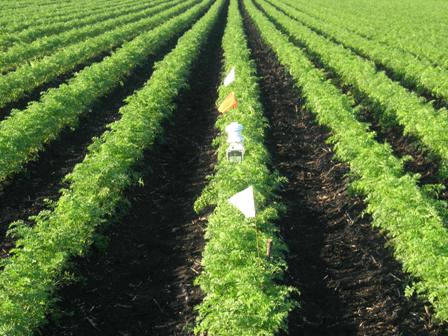Evaluation of Biofungicides for Control of Sclerotinia Disease in Carrots
Prepared by Tom Gonsalves, Manitoba Agriculture, Vegetable Industry Development Specialist
Sclerotinia rot of carrots (see Figure 1) is a major problem for Manitoba’s carrot industry. Prior to the 2010 crop year, no chemical fungicides were registered for use in-field in Canada. Two new biofungicides, Contans™ and Serenade ASO™ have recently been registered for use against Sclerotinia in carrots. Contans™ is a naturally occurring strain of Coniothyrium fungi (Coniothyrium minitans strain CON/M/91-08) and is registered for soil application. This fungus parasitizes the dormant form of sclerotinia, the sclerotia and reduces the amount of sclerotia germinating and producing mycelia infection or ascospores. Serenade ASO™ (a bacterium Bacillus subtilis QST 713 strain) is registered for foliar application on carrots to control Sclerotinia. In order to evaluate the efficacy of these products in commercial scale carrot fields in Manitoba, Manitoba Agriculture, Food & Rural Initiatives (MAFRI) coordinated a project with a carrot producer and United Agri Products (UAP).
Figure 1: Sclerotinia on Carrots in Storage (MAFRI; 2007)

Description of Field Trials
Two fields with a history of sclerotinia disease were selected for evaluation. One field was planted to carrots in 2010 and the second field is planted to wheat in 2010 and will be planted to carrots in 2011.
The field planted to carrots in 2010 had four treatments applied in 3 replicates on the field. Soil samples were taken prior to the application of the treatments to quantify the background levels for sclerotinia in each field. The treatments applied to the carrot field in 2010 are;
- Contans WG™
- Serenade ASO™
- Contans WG™ with Serenade ASO™
- Untreated control (no spray)
The field planted to wheat field this year (carrots in 2011) had three treatments applied to it in 2010. The treatments applied in 2010 were;
- Untreated control
- Contans WG™ (0.4 kg/ha)
- Contans WG™ (0.8 kg/ha)
- There will be a fourth treatment applied in 2011 of Contans WG™ and will be incorporated with tillage.
- All four of these treatments will be split in half in 2011. One half will have no further treatments applied and the other will have Serenade ASO™ applied.
The Contans WG™ treatments on both the carrot and wheat fields were applied on May 28, 2010. There were rain events after the Contans WG™ was applied on each field which incorporated the product into the soil (1 inch plus was recorded on May 28 and another inch plus on May 29). Aside from the biofungicide applications each of the fields are managed by the cooperating producer as per their standard management practices.
Nylon mesh bags containing 50 sclerotia each were prepared in the lab. On June 4, 2010 six bags were buried 1½ to 2 inches below the top of the soil in the carrot bed (see figure 2) and ½ to 2 inches below the top of the soil the wheat field. In the fall of 2010 four bags will be removed from each treatment before freeze up (approximately late August, mid September, mid October and early November) and in the early spring of 2011 the remaining bags will be removed (approximately mid March and mid April). Each time that a bag is removed, the sclerotia will be evaluated in the lab to determine the efficacy of the treatments in reducing the germination of sclerotia.
Figure 2: Mesh Bags Containing 50 Sclerotia Each Buried in Carrot Beds (MB Ag, June 4, 2010)

Data loggers (see figure 3) were installed in each of the fields on June 4, 2010. The loggers collect data on the following parameters;
- Soil temperature
- Soil moisture
- Air temperature
- Relative humidity
Figure 3: Data Logger in Carrot Field (MB Ag; July 8, 2010)

Samples of carrots will be hand harvested from each plot prior to the producer commercially harvesting the field. The samples will be evaluated for yield. The percentage of Sclerotinia incidence and severity will be calculated for each plot. Soil samples will be taken from each treatment in the fall (immediately after the carrots are commercially harvested) and assayed to determine the number of sclerotia present.
Over the winter of 2010/11 the data collected will be statistically analyzed. A report on the 2010 portion of the evaluation will be prepared and made available to Manitoba carrot producers, UAP and any others interested in the project. In 2011 the trial will be completed, the data statistically analyzed and a final report will be prepared and presented to Manitoba carrot producers.
For further information on this project contact Tom Gonsalves or Vikram Bisht, Manitoba Agriculture, Potato and Horticulture Pest Specialist.
